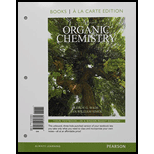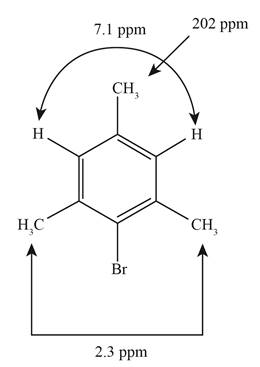
Concept explainers
An unknown compound has the molecular formula C 9 H 11 B r. Its proton NMR spectrum shows the following absorptions:
singlet, δ 7.1, integral 44 mm
singlet, δ 2.3, integral 130 mm
singlet, δ 2.2, integral 67 mm
Propose a structure for this compound.
Interpretation:
The structure of the given unknown compound showing the given absorptions in the NMR spectrum is to be proposed.
Concept introduction:
NMR spectroscopy is a technique used to determine the unique structure of the compounds. It identifies the carbon-hydrogen bonding of an organic compound. A hydrogen atom is called as a proton in the NMR spectroscopy.
Answer to Problem 13.33SP
The structure of the given unknown compound showing the given absorptions in the NMR spectrum is given below.
Explanation of Solution
The molecular formula of the compound (
The double bond equivalent is calculated by the formula,
Substitute the given values in the above expression.
The DBE value is more than three and one signal present at
The other signals present in the NMR spectrum shows that,
From the above data analysis of

Figure 1
The structure of the given unknown compound showing the given absorptions in the NMR spectrum has been rightfully stated.
Want to see more full solutions like this?
Chapter 13 Solutions
Organic Chemistry, Books a la Carte Edition (9th Edition)
 ChemistryChemistryISBN:9781305957404Author:Steven S. Zumdahl, Susan A. Zumdahl, Donald J. DeCostePublisher:Cengage Learning
ChemistryChemistryISBN:9781305957404Author:Steven S. Zumdahl, Susan A. Zumdahl, Donald J. DeCostePublisher:Cengage Learning ChemistryChemistryISBN:9781259911156Author:Raymond Chang Dr., Jason Overby ProfessorPublisher:McGraw-Hill Education
ChemistryChemistryISBN:9781259911156Author:Raymond Chang Dr., Jason Overby ProfessorPublisher:McGraw-Hill Education Principles of Instrumental AnalysisChemistryISBN:9781305577213Author:Douglas A. Skoog, F. James Holler, Stanley R. CrouchPublisher:Cengage Learning
Principles of Instrumental AnalysisChemistryISBN:9781305577213Author:Douglas A. Skoog, F. James Holler, Stanley R. CrouchPublisher:Cengage Learning Organic ChemistryChemistryISBN:9780078021558Author:Janice Gorzynski Smith Dr.Publisher:McGraw-Hill Education
Organic ChemistryChemistryISBN:9780078021558Author:Janice Gorzynski Smith Dr.Publisher:McGraw-Hill Education Chemistry: Principles and ReactionsChemistryISBN:9781305079373Author:William L. Masterton, Cecile N. HurleyPublisher:Cengage Learning
Chemistry: Principles and ReactionsChemistryISBN:9781305079373Author:William L. Masterton, Cecile N. HurleyPublisher:Cengage Learning Elementary Principles of Chemical Processes, Bind...ChemistryISBN:9781118431221Author:Richard M. Felder, Ronald W. Rousseau, Lisa G. BullardPublisher:WILEY
Elementary Principles of Chemical Processes, Bind...ChemistryISBN:9781118431221Author:Richard M. Felder, Ronald W. Rousseau, Lisa G. BullardPublisher:WILEY





